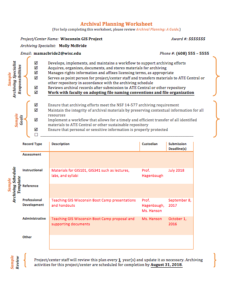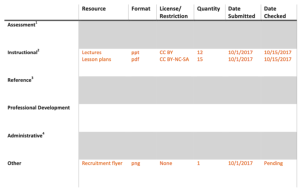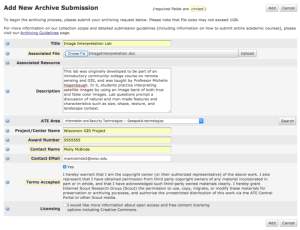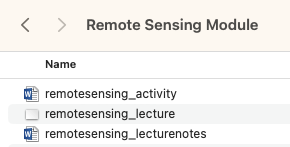The purpose of this guide is to help you make important decisions as to how you want your materials stored long-term and to aid you in preparing your materials according to ATE Central guidelines. If you have any comments, questions, or concerns about this guide or about archiving with ATE Central in general, please feel free to contact us at [email protected].
How to Use this Guide
This guide follows the ATE Central archiving checklist; reviewing the checklist is the first step in preparing for long-term storage of your valuable resources. This checklist is not meant to be comprehensive; rather, it highlights key questions that may help you plan your archiving activities. Take a moment to review the checklist and see where you are in the archiving process or perhaps what questions you may still need to explore. If your answer to any (or even many) of the checklist questions is still “no,” simply keep reading. We’ll cover much of this material below.
1. Get Informed
The ATE Central archiving service is available to all ATE projects and centers free of charge. While archiving efforts can begin at any time during your funding cycle, ATE PIs who plan to archive with ATE Central at the onset of their funding can more effectively prepare for easy ingestion of their deliverables into the ATE Central resource portal.

Make use of ATE Central's archival planning worksheet (pdf, docx) and sample spreadsheet (pdf, docx) as you work your way through the checklist! The worksheet will guide you in assigning roles, setting goals, and creating your own personalized archiving schedule.
An example of a completed archiving worksheet is to the right. Click on the image to enlarge.
To learn more about the ATE Central archiving service, listen to our most recent archiving webinar or contact us directly at [email protected].
Who is required to archive?
Grantees who were awarded funding under solicitation NSF 14-577 (2014-16) or who apply for and receive funding under NSF 17-568 (2017-19) are required to archive their deliverables with ATE Central. It is important to note that those who receive any new funding (e.g. a center that transitions from regional to national or from national to support center; or a project or center that receives a new round of funding) are also required to archive deliverables created under the new award.
What do I need to archive?
Projects and centers need to archive their deliverables (e.g. curriculum, professional development, and recruitment materials) that exist at all in a digital form, as described in their initial grant proposals. Deliverables should be stored in an archivable format and have clear intellectual property information affixed. ATE Central staff is available to help with the selection process; please do not hesitate to contact us at [email protected].
What does it mean to license my work?
When others want to make use of the materials you’ve created, they may choose to contact you and solicit your permission to do so. As copyright holder, it is your decision whether you want to grant permission or not—in essence, whether you want to license your intellectual property (that is otherwise protected by U.S. copyright law) in some way.
The nonprofit organization Creative Commons (CC) provides standardized and legally vetted licenses that encourage sharing and reuse of copyrighted works. When you affix a CC license to the materials you've created, you're granting permission to distribute, use, or build upon your protected work to others, in advance, without them having to contact you.
 For example, if you affix a CC Attribution-Noncommercial-ShareAlike license to your work, others may "remix, tweak, and build upon your work non-commercially, as long as they credit you and license their new creations under the identical terms.” Because you’ve clearly stated the terms under which others can use the work, they can rest assured that they are not violating your rights in any way, as you’ve already granted permission for their use.
For example, if you affix a CC Attribution-Noncommercial-ShareAlike license to your work, others may "remix, tweak, and build upon your work non-commercially, as long as they credit you and license their new creations under the identical terms.” Because you’ve clearly stated the terms under which others can use the work, they can rest assured that they are not violating your rights in any way, as you’ve already granted permission for their use.
How do I choose and apply a CC license to my work?
If you’re considering whether to make your work available under a CC license, first take a moment to review these licensing considerations. Next, familiarize yourself with the various CC licenses and how they differ from one another. If you choose to license your work, the final step is to affix the appropriate license (depending on what permissions you want to grant) directly to the material in question. It’s that easy!
Grantees are encouraged to consider licensing their work under any of the following licenses: Attribution (CC BY), Attribution-ShareAlike (CC BY-SA), and Attribution-NonCommercial-ShareAlike (CC BY-NC-SA). These licenses allow potential users to copy, distribute, transmit, and adapt the copyrighted work as long as they attribute the work in the manner specified by the grantee. In licensing your work, you are not only adhering to NSF recommendations to make federally-funded content more freely available, but are also actively encouraging others to make use of your work.
Note: Intellectual property handling for software is different from that for other materials, but NSF does expect that software source code developed with ATE grant funds be released under an open license that allows others to use and build upon the work. Please visit the Open Source Initiative for acceptable licensing options for software.
2. Roles and Responsibilities
While the PI of any ATE project or center is ultimately responsible for data management and archiving efforts, identifying a staff person to oversee day-to-day archival activities streamlines workflow and will likely result in a more cohesive approach to managing your materials. This person need not be the project/center PI and may be someone else in the organization. Regardless of who is selected as the archiving specialist, it is important to define this person’s role and communicate that role to others. Responsibilities will surely differ by project or center. Use the archival planning worksheet to help define and communicate these roles.

3. Plan your Archiving Activities
In preparation for archiving with ATE Central, think about what you seek to accomplish in archiving your materials; identify what materials you’d like to archive, how and when you’ll archive them, and how you’ll track your progress.
What are archiving goals?
Your archiving goals might cover a number of areas, such as compliance, accountability, availability, transparency, integrity, disposition, retention, or protection. A few sample goals are provided on the archival planning worksheet; your goals may be similar or perhaps even more strategic in nature.

What kinds of materials should I archive with ATE Central?
ATE Central collects an assortment of assessment, instructional, reference, and professional development materials that are created and/or collected by ATE-funded initiatives.
Additionally, the ATE Central resource portal provides access to those materials generated by ATE-funded initiatives that may serve as samples or otherwise be of use to the ATE community in broadening their impact, developing leaders, recruiting students, educating technicians, managing programs, advancing innovation through research, or engaging industry. Samples include research reports, best practices, manuals and guides, policy or procedural documents, or data collection tools such as surveys.
Project and center deliverables and sample resources are made freely available via the ATE Central resource portal. ATE project and center PIs are, however, welcome to request restricted access to materials, when appropriate. For example, access to fee-based curriculum may be restricted as to not negatively impact the interests of the project or center that created it.
What formats are acceptable?
To promote accessibility, ATE Central asks that you submit resources in the following file formats:
-
Audio (max. 250 MB per file): AAC*, .mp3, .alac, .ogg, .flac
-
Video (max. 250 MB per file): .avi, .mkv**, .mp4
-
Visual (max. 1 GB per file): .bmp, .jpeg, .gif, .png
-
Textual (max. 250 MB per file): Microsoft (.docx, .xlsx, .pptx)
-
LMS: .imscc
However, we are more than happy to discuss adding other formats, especially those that might be specific to your field of study. If you have other types of materials that you are interested in archiving and that are not listed above, please contact ATE Central staff at [email protected] for more information.
* No copy-protected submissions permitted (.m4a, not .m4p) **Must play on VLC Media Player
When should I submit for archiving?
Once you’ve selected your archiving specialist and have identified your archiving goals, consider what types of materials you will generate over the course of your grant and draw up a basic archiving schedule. Schedules will differ significantly by project and center.
Most projects and centers will create materials that fall within one or more of the following areas: assessment, instruction, reference, or professional development; each will also create materials that are administrative in nature. Some materials may fit into more than one category, while other materials won’t fit into any single category, and that’s perfectly fine. The goal is simply to group like materials in a way that will guide your archiving specialist’s decision making.
In your schedule, give a brief explanation of each type of material, who maintains the material described, and when you intend on archiving each type of material.

Once your archiving specialist has an idea of what to collect, (s)he can use this schedule to keep more thorough documentation (see sample spreadsheet discussed below) as your project progresses and make informed decisions about when it makes sense for your project or center to submit materials.
4. Develop a Workflow

Now that you’re well informed, have identified your archiving specialist, and have a plan of action outlined for your archiving activities, it’s time to develop a workflow. Think about how and when your specialist will solicit materials from those who develop the materials, where (s)he will store those materials before submitting to ATE Central, what information you might want to retain about each resource and where that information will be stored, and which licenses (if any) you will choose to use.
Consider developing a spreadsheet, such as the one depicted to the right (click to enlarge), or other tool to track this formation.

Submitting materials to ATE Central
Before submitting your materials for archiving with ATE Central, you'll be asked to log in or setup a new user account, if you don't already have one. The login screen is depicted to the right; click to enlarge.
Submitting individual resources
To submit an individual resource for archiving, simply complete our Archive submission form. Please feel free to complete this form for as many resources as you like. If you have related resources that you'd rather not separate into multiple submissions, you may also submit a collection of related resources as described below.
Click on the image below, to enlarge the example submissions.

Example: Submitting an individual resource
Submitting a collection of related resources
For a collection of related resources (e.g. multiple lesson plans, workshop handouts, a video series, etc.), please submit a single ZIP file via the Archive submission form. Your ZIP file should contain one copy of each of your resources, and the use of sub-folders to organize your materials is encouraged. If you’re unsure how to compress a folder into a ZIP or need additional assistance in preparing your files for transfer, please do not hesitate to contact us. We’re happy to help!

Example: A sample collection of related resources

Example: Submitting a collection of related resources
Submitting an academic course
To submit an entire academic course, please upload a single ZIP file to the Archive submission form. This ZIP should contain at least the first two—when appropriate all four—of the following files:
-
A copy of the course syllabus;
-
Subfolders containing all audio, video, visual, and textual resources;
When appropriate:
-
One screen-capture of the LMS course main page; and
-
One validated IMS Common Cartridge file containing the course in LMS-compatible form.
If you're interested in exporting course materials from your learning management systems, such as Blackboard or Moodle, and submitting them directly to ATE Central, please contact us for assistance. Exported files must meet IMS Common Cartridge (IMS CC) standards. Specifications are available at http://www.imsglobal.org/cc/index.html.

Example: A well organized course sample showing subfolders and syllabi
Completing the submission process
Pending and completed archiving requests will display here. Please feel free to edit your submission(s) as long as the submission status is "Unreviewed" or contact us directly if you have questions regarding your submission.
You will receive a confirmation email once your request has been fully processed. After processing is complete, each submission will be linked to the completed archival record for your review.
5. Follow-up
Like with any project, it’s a good idea to review your schedule with some frequency and to double-check that you’ve done what you set out to do by the end of your funding cycle. Adding a regular review process to the body of your plan will help your archiving specialist keep on track.

Questions and Comments
ATE Central staff members are committed to helping you successfully transfer your resources to the ATE Central Archive with ease. We welcome any and all questions, comments, or concerns that you may have at [email protected].